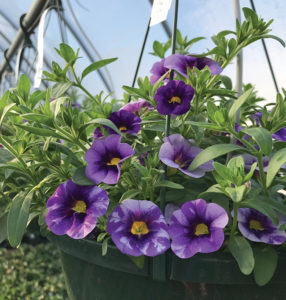
Bacteria & Viruses Having a Field Day This Year
Pathogens had a field day in spring 2022, while we made trips to the dumpster.
The big problems this year required that plants be discarded, not treated. We just do not have highly effective preventive treatments for bacteria and viruses: we need reliable clean stock production.
GERANIUM AFFLICTIONS

(Photos: Margery Daughtrey)
Bacterial blight of geraniums (Xanthomonas hortorum pv. pelargonii), a common plague in the 20th century, had of late become a distant, distasteful memory. Important threats like Western flower thrips and Ralstonia solanacearum have been the nightmares of the new century. After troubles in 2003-2004 with Ralstonia solanacearum Race 3 Biovar 2 (RsR3Bv2, a USDA Select Agent subject to a quarantine order) were so disastrous, stringent guidelines were put into place for geranium cutting production, so it became a much safer crop to grow. In 2020, for the first time in a long while, RsR3Bv2 snuck into the U.S. on a few cultivars, but there was no return of the contagion in the next year.

on geranium — leaf spots on ivy geranium cutting.
But this year, our old nemesis Xanthomonas struck again! Our diagnostic lab alone handled over a hundred samples. Although not as “serious” a problem as Ralstonia because there is no federal quarantine order regarding it, Xanthomonas bacterial blight is a very, very contagious disease of zonal, ivy and hybrid geraniums, both seed-grown and cutting- grown. Thus, it represents the potential for complete geranium crop loss.
Seed-grown hybrid geraniums should not be produced in the same house with cutting-grown geraniums, so that they will escape epidemics. A crop of hybrid seedling geraniums can stay scot-free of Xanthomonas as long as it is physically removed from its cutting cousins.

The contagiousness of Xanthomonas was amply demonstrated this year. A wide range of cultivars were seen with the disease: zonal, ivy, hybrid and even the innocent hybrid seed geraniums. Plants originating from various propagators were ultimately affected even though a single incursion of bacteria is thought to have initiated the problem. Researchers are currently studying the DNA of bacterial isolates to examine the pathogen population in detail.
Growers have asked whether Xanthomonas can live on other plants — yes, these bacteria can survive on other plants at least temporarily. So different crop species that have been sitting next to geraniums with bacterial blight, or beneath a diseased hanging basket crop, can provide inoculum if they are moved near healthy geraniums. This cross-crop transfer would be most likely to occur if there were overhead watering in both locations. In a greenhouse trial at the University of Minnesota published in 1987, a verbena, an impatiens and a fuchsia were all found to still harbor X. hortorum pv. pelargonii 28 days after the foliage was sprayed with a bacterial suspension.

Bacterial blight is not just a splash-spread leaf spot disease; roots can be the location of infection. The disease can become systemic in either case. If geraniums share a capillary mat or a subirrigation system, a few sick plants can become many.
Symptoms can be latent, especially in winter months. As the weather warms, bacteria harbored within the stem multiply, and infected plants will grow poorly, wilt and rot.
Symptoms and susceptibility levels vary from one cultivar to the next. The more chlorosis (yellowing) a geranium tends to show, the more easily you will notice when it is infected. It also matters when and how the plant became infected. When a geranium is grown from a latently-infected cutting under warm conditions, overhead watering will splash bacteria from it to others nearby, causing leaf spots. The spots are small, round, brown, sunken and about 1/16 to 1⁄8 inch in diameter.

Growers often find it easier to detect X. hortorum pv. pelargonii infection on zonals rather than on ivy geraniums or hybrids because Pelargonium peltatum has firm leaves that do not wilt easily.
Will Xanthomonas survive in the greenhouse until next spring? Probably not, as long as you eliminate all geranium plant debris from the greenhouse and disinfect greenhouse surfaces after the diseased crop is removed. Don’t keep over any geraniums. In that same Minnesota study, bacteria were shown to survive 221 days within air-dried leaves but perished in only 11 days in geranium leaves buried in soil. It’s generally a whole new ball game the next season when it comes to bacterial blight.

blight on geranium — leaf spots with chlorosis.

CALIBRACHOA TROUBLES
Other crops had their problems, too. Chili pepper mild mottle virus (CPMMoV) created a flurry of calibrachoa disposals this year. In the past, we have occasionally seen a different virus, calibrachoa mottle virus (CbMV, a carmovirus), which has negative effects on plant quality, especially on stressed plants. This year’s scourge, however, is a relative of tobacco mosaic virus (TMV) that had been reported previously only on pepper plants in Brazil.

Chili pepper mild mottle virus this year caused stunting and a very dramatic flower break in some cultivars, but leaf mottling was more subtle and harder to see.
As with other tobamoviruses, this virus is spread by merely handling the plants, so the problem was likely distributed before growers realized the pathogen was on the premises.
Fortunately, the Agdia immunostrip test for TMV was found to detect CPMMoV, so growers were able to use that tool to check suspicious symptoms and identify infected material for discard.
Although there were also a few scattered cases of TMV seen on petunia and calibrachoa this year, TMV itself did not appear to be widespread this season.
Regardless, as long as TMV test kits indicated a positive, it was a good decision to discard calibrachoa with virus symptoms, no matter what tobamovirus was involved.


(Photo Elise Lobdell)
OTHER CROP PROBLEMS TOO
Another virus problem, alternanthera mosaic virus (AltMV, a potexvirus) was seen on portulacas for the first time in a number of years. The symptoms were misshapen leaves, with irregular outlines and pale spots.
And losses to impatiens necrotic spot virus (INSV) were also high in some greenhouses. One business encountered two INSV-infected crops: New Guinea impatiens (brown zonate leaf lesions) and Nonstop begonias (pronounced yellow leaf mottling).
Interestingly, chickweed on the greenhouse floor also tested positive.
It is important to remember weed control when you are trying to eradicate thrips-borne tospoviruses (INSV as well as tomato spotted wilt virus, TSWV) from your greenhouse! Test kits specific for AltMV, INSV and TSWV are all available to help you. Good scouting and prompt roguing out are your best defenses against these intractable bacterial and viral diseases.


 Video Library
Video Library 



















